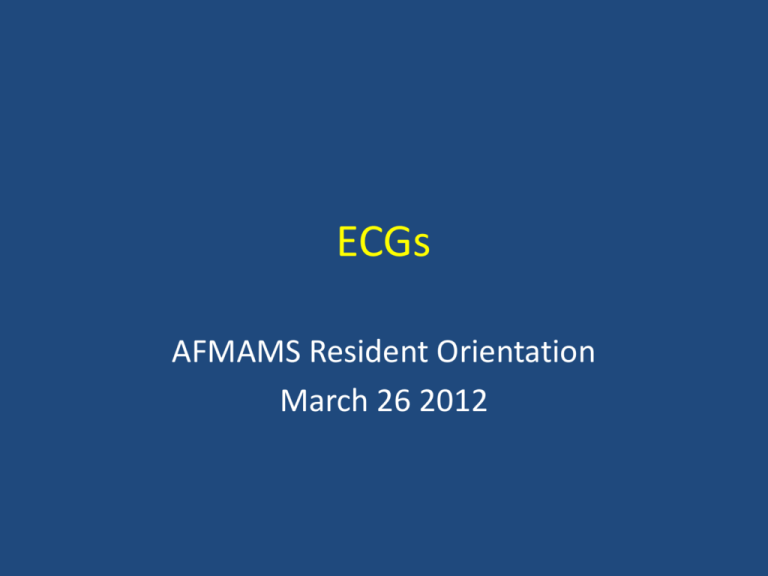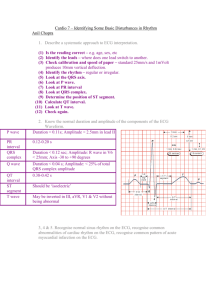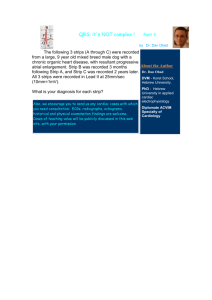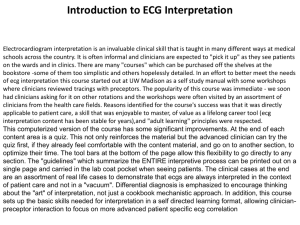ECG Lecture1
advertisement

ECGs AFMAMS Resident Orientation March 26 2012 Lecture Outline • • • • • • • • ECG Basics Importance of systematically reading ECGs Rate Rhythm Axis Hypertrophy Intervals and Segments Ischemia / Infarction ECG Basics • Measurements on ECG paper Identify ECG Landmarks Introduction • Be systematic – – – – Rate Rhythm Axis Chamber Hypertrophy • Atrial • Ventricular – Intervals – Ischemia / Infarction • Read Every ECG the same way! How to Determine Rate • Rhythm Strip – 10 seconds – Count QRS complexes then multiply by 6 • Count Big Blocks between QRS complexes • 300-150-100-75-6050-43-37 Determining Rhythm • Look for the P wave – Leads II and V1 • Present vs. Absent • Regular vs. Irregular • Symmetric vs. Asymmetric • Normal Sinus Rhythm is most common Normal P wave morphology • P wave represents atrial activation • The atria activate from right to left, so the first half of the P wave usually represents right atrial activation and the second half represents the left atrium. • The sinus node is the usual sight of atrial activation. Definition of Sinus Rhythm • NOT “A P wave before every QRS” ACTUAL DEFINITION OF SINUS RHYTHM • Normal P wave axis • Uniform P wave morphology • Regular P-P interval Rhythm • P waves: normal sinus (NSR), sinus bradycardia, sinus tachycardia, multifocal atrial tachycardia (MAT), atrial flutter • No P waves: atrial fibrillation, junctional rhythm, ventricular fibrillation, ventricular tachycardia • Regular: normal sinus, sinus bradycardia, sinus tachycardia, atrial flutter, junctional rhythm, ventricular tachycardia • Irregular: atrial fibrillation, multifocal atrial tachycardia, ventricular fibrillation Normal P wave morphology • Normal P wave duration: 0.08 – 0.11 seconds • Normal P wave amplitude: limb leads < 2.5mm; V1 positive deflection < 1.5mm and negative deflection < 1mm • Normal P wave axis: 0-75 degrees • Normal morphology: upright in I, II, aVF Normal P wave morphology • P wave duration (seconds): measured from the beginning of the P wave to the end of the P wave. • Amplitude (mm): measured from the baseline to the top (or bottom). Positive and negative deflections are determine separately. Question: Is this patient in normal sinus rhythm? Axis • Refers to the direction of the movement of depolarization spreads through the heart • Since left ventricle is the largest and thickest chamber of the heart it undergoes most depolarization • Therefore, normal direction of depolarization is from middle of the chest towards the left hip Axis • Important in determining – Prior myocardial infarction – Ventricular Hypertrophy – Intraventrcicular Conduction Delay • Two methods to calculate axis – Isoelectrical – Short-cut Isoelectrical Calculation • Find the isoelectrical QRS complex • Axis is perpendicular to isoelectrical axis • Use other leads to determine if positive or negative Short Cut Method • Look at Lead I and II • If QRS positive in Leads I and II – Normal axis • If QRS negative in I and positive in II – Right Axis Deviation • If QRS positive in I and negative in II – Left Axis Deviation • If QRS negative in Leads I and II – Far Right Axis Deviation Atrial Abnormalities • Left Atrial Enlargement – Terminal negative P wave in lead V1 >1mm deep and 0.04sec in duration – Notched P wave with a duration >0.12sec in limb leads (I, II) – Seen in: MS, MR, LVH • Right Atrial Enlargement – Tall P wave in inferior leads - >2.5mm – Can be seen in: COPD, PE, Pulmonary HTN LVH • Cornell Criteria – R in AVL + S in V3 > 28mm (>20mm in females) • Voltage Criteria – S in V1 + R in V5/V6 > 35mm – R in AVL > 11mm – Largest R in limb leads >20 • Supporting Criteria – – – – LAE LAD Prolonged QRS Strain pattern RVH • • • • • • • • • Right axis deviation (>+90) R V1 >7 mm R V1 + S V5 or V6 >10 mm R/S ratio in V1 >1 S/R ratio in V6 >1 Incomplete right bundle branch block ST-T wave abnormalities ("strain") in inferior leads Right atrial hypertrophy (P pulmonale) S1- S2 - S3 pattern (particularly in children Intervals • PR interval • QRS Complex • QT Interval The PR interval • Normal interval: 0.12 – 0.20 seconds in length • Short PR interval: < or = 0.11 seconds • Long PR interval: > 0.20 seconds Pericarditis • Diffuse ST segment depressions • PR depression • Notching of the S wave Wolf Parkinson White • Short PR interval • Wide QRS complex • Presence of a delta wave • ST-T wave changes or abnormalities • Clinical association with paroxysmal tachycardias QRS Complex • Normal QRS duration – 80 – 120 ms • Widened QRS – RBBB – LBBB – Electrolyte abnormalities RBBB • Asynchronous activation of the two ventricles increases the QRS duration (0.13 sec). • Terminal forces are rightward and anterior due the delayed activation of the right ventricle, • Results in an rsR' pattern in the anteriorposterior lead V1 and a wide negative S wave in the lead V6 and Lead I • No significant association with risk factors for or the presence of ischemic heart disease, myocardial infarction, or cardiovascular deaths RBBB Criteria • QRS > 120 ms • rSR’ or rsR’ in V1 • Wide S in I, V5 or V6 RBBB LBBB Criteria • QRS duration > 120 ms • QS or rS complex in V1 • RsR’ in V6 • T wave deflection should be opposite QRS complex (Discordance) LBBB QT Interval • Normal – Male < 440 ms – Female < 460 ms • Calculated – QTc = QT / RR • Prolonged – Electrolytes – Inherited • Shortened – Hypercalcemia Long QT Conclusions • ECGs are a cheap and readily available diagnostic test • ECGs provide a tremendous amount of information • Properly interpreting ECGs requires a lot of practice Second Degree AV Block • Mobitz Type I – Progressive prolongation of the PR interval until a P wave is blocked – RR interval containing the nonconducted P wave is less than two PP intervals – Usually narrow QRS (block at the level of AV node) • Mobitz Type II – Intermittent nonconducted P waves – Constant PR interval – RR interval containing the nonconducted P wave is equal to two PP intervals – Often a wide QRS complex Third Degree AV Block • Atrial and ventricular rhythms are independent of one another • PP and RR intervals are constant • Atrial rate > ventricular rate








